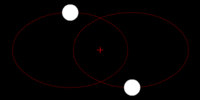Gravitational two-body problem

Imagine you have two big balls floating in space, and they are attracted to each other by something called gravity. The first ball wants to pull the second ball close to it, while the second ball wants to do the same thing to the first one.
Now, let's pretend that both balls are magic: they can move around in any direction, and they won't stop moving unless they crash into something. What happens to them over time? Well, that's the gravitational two-body problem.
Scientists like to study this problem because it helps them understand how objects move in space, like planets orbiting around the Sun. They use math to figure out how the two magic balls move in relation to each other, based on their masses, their distance apart, and the force of gravity pulling them together.
One important thing they found out is that the two balls will always move in an elliptical path around each other, never a straight line. The size and shape of this path depends on how fast they are moving and how strong their gravity is.
Sometimes, the balls will go very far away from each other, and sometimes they will get very close or even crash into each other. But if they keep moving around each other, they will always follow the same path, like a dance that never ends. And that's how gravity works in space!
Now, let's pretend that both balls are magic: they can move around in any direction, and they won't stop moving unless they crash into something. What happens to them over time? Well, that's the gravitational two-body problem.
Scientists like to study this problem because it helps them understand how objects move in space, like planets orbiting around the Sun. They use math to figure out how the two magic balls move in relation to each other, based on their masses, their distance apart, and the force of gravity pulling them together.
One important thing they found out is that the two balls will always move in an elliptical path around each other, never a straight line. The size and shape of this path depends on how fast they are moving and how strong their gravity is.
Sometimes, the balls will go very far away from each other, and sometimes they will get very close or even crash into each other. But if they keep moving around each other, they will always follow the same path, like a dance that never ends. And that's how gravity works in space!
Related topics others have asked about:
